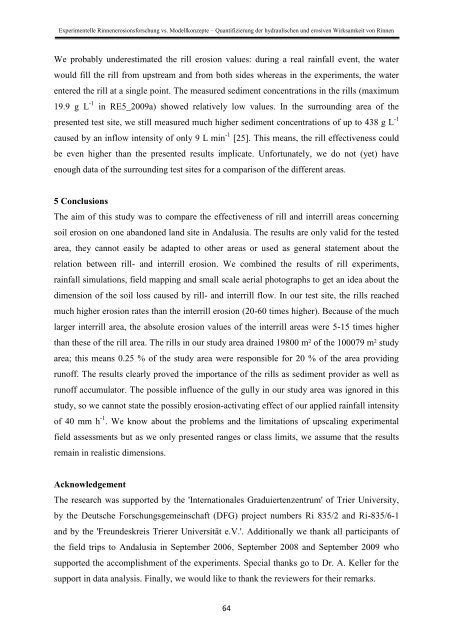Stefan Wirtz Vom Fachbereich VI (Geographie/Geowissenschaften ...
Stefan Wirtz Vom Fachbereich VI (Geographie/Geowissenschaften ...
Stefan Wirtz Vom Fachbereich VI (Geographie/Geowissenschaften ...
You also want an ePaper? Increase the reach of your titles
YUMPU automatically turns print PDFs into web optimized ePapers that Google loves.
Experimentelle Rinnenerosionsforschung vs. Modellkonzepte – Quantifizierung der hydraulischen und erosiven Wirksamkeit von Rinnen<br />
We probably underestimated the rill erosion values: during a real rainfall event, the water<br />
would fill the rill from upstream and from both sides whereas in the experiments, the water<br />
entered the rill at a single point. The measured sediment concentrations in the rills (maximum<br />
19.9 g L -1 in RE5_2009a) showed relatively low values. In the surrounding area of the<br />
presented test site, we still measured much higher sediment concentrations of up to 438 g L -1<br />
caused by an inflow intensity of only 9 L min -1 [25]. This means, the rill effectiveness could<br />
be even higher than the presented results implicate. Unfortunately, we do not (yet) have<br />
enough data of the surrounding test sites for a comparison of the different areas.<br />
5 Conclusions<br />
The aim of this study was to compare the effectiveness of rill and interrill areas concerning<br />
soil erosion on one abandoned land site in Andalusia. The results are only valid for the tested<br />
area, they cannot easily be adapted to other areas or used as general statement about the<br />
relation between rill- and interrill erosion. We combined the results of rill experiments,<br />
rainfall simulations, field mapping and small scale aerial photographs to get an idea about the<br />
dimension of the soil loss caused by rill- and interrill flow. In our test site, the rills reached<br />
much higher erosion rates than the interrill erosion (20-60 times higher). Because of the much<br />
larger interrill area, the absolute erosion values of the interrill areas were 5-15 times higher<br />
than these of the rill area. The rills in our study area drained 19800 m² of the 100079 m² study<br />
area; this means 0.25 % of the study area were responsible for 20 % of the area providing<br />
runoff. The results clearly proved the importance of the rills as sediment provider as well as<br />
runoff accumulator. The possible influence of the gully in our study area was ignored in this<br />
study, so we cannot state the possibly erosion-activating effect of our applied rainfall intensity<br />
of 40 mm h -1 . We know about the problems and the limitations of upscaling experimental<br />
field assessments but as we only presented ranges or class limits, we assume that the results<br />
remain in realistic dimensions.<br />
Acknowledgement<br />
The research was supported by the 'Internationales Graduiertenzentrum' of Trier University,<br />
by the Deutsche Forschungsgemeinschaft (DFG) project numbers Ri 835/2 and Ri-835/6-1<br />
and by the 'Freundeskreis Trierer Universität e.V.'. Additionally we thank all participants of<br />
the field trips to Andalusia in September 2006, September 2008 and September 2009 who<br />
supported the accomplishment of the experiments. Special thanks go to Dr. A. Keller for the<br />
support in data analysis. Finally, we would like to thank the reviewers for their remarks.<br />
64
















